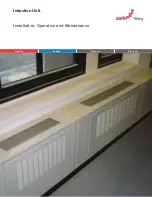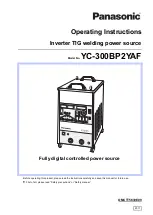
B. INSTALLATION OF TRACK HARDWARE, DOOR &
ELECTRIC OPERATOR
(1) Install the #25 track support brackets ensuring they
are level and straight.
Note:
For through the wall applications, drill the hole
for the through the wall drive shaft assembly prior to
mounting the track support brackets.
(2) Install #25 track ensuring level and straight. Weld all
joints of the #25 track using Crown’s #25-X374 welding
jig.
(3) Install Chain Guide Track above #25 Track.
(4) For bi-parting applications install Center Idler
assembly.
(5) Install #25 four wheel ball bearing trucks in track.
Attach the Trolley/Chain Connector Link to the top of the
lead truck.
(6) Install door(s). Ensure doors hang plumb and true.
Confi rm the doors slide properly.
(6) Install the Model 405DC-MC electric operator.
C. INSTALLATION OF ROLLER CHAIN
(1) Disengage the operator by pulling and holding open
the release arm at the mechanical disconnect. This
will allow the door(s) and operator output shaft to move
freely.
(2) Move the door(s) to the full closed position.
(3) Connect one end of a length of roller chain to the
lead side of the Trolley/Chain Connector Link. Run this
length of roller chain up around the end idler (center idler
for biparting applications), then down the Chain Guide
Track. Attach the roller chain to the lead end of the
Chain Tensioner assembly.
Note
: The Chain Tensioner
assembly should be resting in the Chain Guide Track at
a point farthest from the opening.
Warning
: During the opening operation there should
be a suffi cient amount of roller chain for the Chain
Tensioner assembly to travel towards the opening but
never to reach the idler. If the Chain Tensioner assembly
attempts to go around the end idler (center idler for bi-
parting applications) it will damage the assembly.
(3a.) For applications where the opening is larger than
8’-0" wide, Sag Rollers at 5’-0" centers will already
integrated into the roller chain. The roller chain with the
fi rst sag roller located 5’-0" from the end, is the length of
roller chain that should be connected to the lead end of
the Trolley/Chain Connector Link. Install only the side
of the roller chain with the sag roller located in 5’-0" from
the end to the Trolley/Chain Connector Link.
(4) Attach the second length of roller chain to the trailing
side of the Trolley/Chain Connector Link. Run this length
of roller chain down the #25 box track, up around the
end idler until you reach the Chain Tensioner assembly.
(5) Remove additional slack from the roller chain then
cut to length and attach the cut roller chain to the end
of the trailing side of the Chain Tensioner assembly.
Further, adjust the Chain Tensioner assembly to
minimize slack in the chain.
(5) Manually slide the door(s) to the full open and back
to the full closed positions several times, checking that
the Chain Tensioner stops short of contacting the end
idlers. Confi rm the doors slide freely. If the doors are
diffi cult to move, the tension in the chain may be too
tight and should be corrected at the Chain Tensioner
assembly.
Caution: Excessive chain tightness could cause
extreme wear on the idler sprockets, shortening
life. Conversely, a loose chain could jump the drive
sprocket and jamb or change door stopping points.
D. WIRING OPERATOR
(1) 405DC-MC electric door operator is intended for
applications where motor branch circuits with voltage
and current characteristics meet operator ratings. Branch
circuit, branch circuit disconnecting means and branch
circuit overcurrent protection are to be properly sized in
respect to the operator horsepower rating.
WARNING: Ensure operator branch circuit is
disconnected from power source when installing,
adjusting, or servicing operator.
(2) Wire operator and control circuit as shown on the
wiring diagram in the packing list envelope. Be sure all
power is off.
E. MOTOR ROTATION
(1) Ensure the mechanical disconnect at the operator is
still disengaged. See part C. Installation of Roller Chain
part #2.
(2) Determine if the system controls are set up as
Momentary or Constant pressure.
Constant Pressure
: Each time the actuator is depressed
the operator is energized. The operator will run only
when the actuator is held in the depressed position.
Crown Industrial Operators • 213 Michelle Ct. • So. San Francisco, Ca 94080-6202
Phone: (650) 952-5150 • Fax: (650) 873-1495
www.crown-industrial.com Email: [email protected]
G-2001
2



























